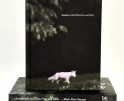Kentaro Kumon: Nemurushima – The Sleeping Island
When in Japan with Nobechi Creative, I was introduced to another artist, Kentaro Kumon and his book, Nemurushima – The Sleeping Island that focuses on Teshima, one of the 28 islands of the Shiwaku Islands in Japan. In former times the island has been famous for its navy, and the island’s shipbuilding and ship handling skills were valued and played a major role in maritime distribution. Today, there are only a dozen or so islanders living on Teshima. The terraced elds that once covered the mountains have been swallowed up by bamboo forest, including the stone walls that had been left. The island’s last sherman passed away at the end of last year, and his shing boat remains tied up in the harbor, swaying in the waves. Listening to the island’s quiet sleep without disturbing it will lead us to face the present situation of Japan as an island nation.
Kentaro Kumon – Nemurushima. The Sleeping Island from Kehrer Verlag Heidelberg on Vimeo.
The Sleeping Island
Whether it was due to the warm spring weather or a breeze blowing across the Seto Inland Sea, the island of Teshima seemed to have fallen asleep, quietly breathing. The ferry dropped me off along with a few other passengers who had come to visit family graves. Then it sailed out to sea, back to Marugame an hour away, leaving large waves that rattled the fishing boats moored in the harbor. It was the end of March, and the cherry buds were beginning to pop. The silence was overwhelming.
One of the twenty-eight Shiwaku Islands, Teshima was famous for its navy during the Warring States period (1467—1568), and the islanders’ shipbuilding and shiphandling skills were highly valued in the Edo period (1603—1868). But now there are only a dozen or so inhabitants; a bamboo forest has swallowed up the terraced fields that once covered the mountains, and although his boat still bobs in the harbor, the island’s last fisherman died a year ago.
Teshima sleeps quietly, undisturbed. In its breath, we might hear the ebb and flow of our own mutable lives.
Born in 1981, photographer Kentaro Kumon focuses on reportage and portraiture in a wide range of fields, including magazines, books, and advertising. He takes a special interest in landscapes shaped by human activity. Recent works include Tagayasu Hito (Cultivators), photographs of agricultural landscapes across Japan; Koyomi-gawa, which explores the relationship between people and rivers; and Hikari no Chikei (Terrain of Light), featuring the diverse landscapes, cultures, and lifestyles on the peninsulas of Japan. Most recent work is “Sleeping Islands,” a series of photographs of islands in the Seto Inland Sea. The book of photographs was published by KEHRER in Germany.
Posts on Lenscratch may not be reproduced without the permission of the Lenscratch staff and the photographer.
Recommended
-
One Year Later: Anna RottyJuly 18th, 2024
-
Tom Griggs: A Creature Obeys a Creature That WantsJuly 15th, 2024
-
Tim Carpenter: Little : The Ice PlantJuly 6th, 2024
-
Mark Alice Durant: Summer of the White Fox, and AfterJune 22nd, 2024
-
Lana Z Caplan: Oceano (for seven generations)June 20th, 2024

































































